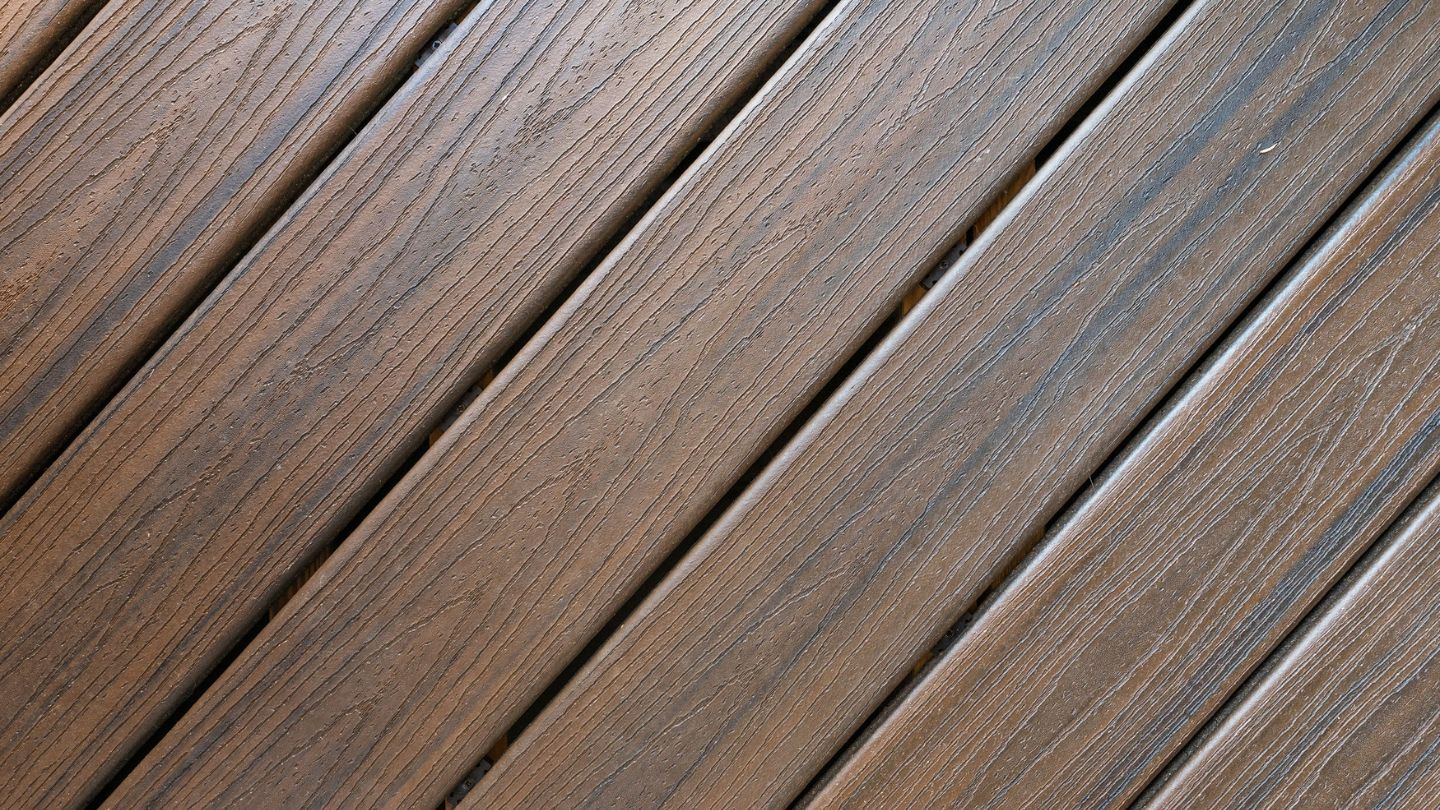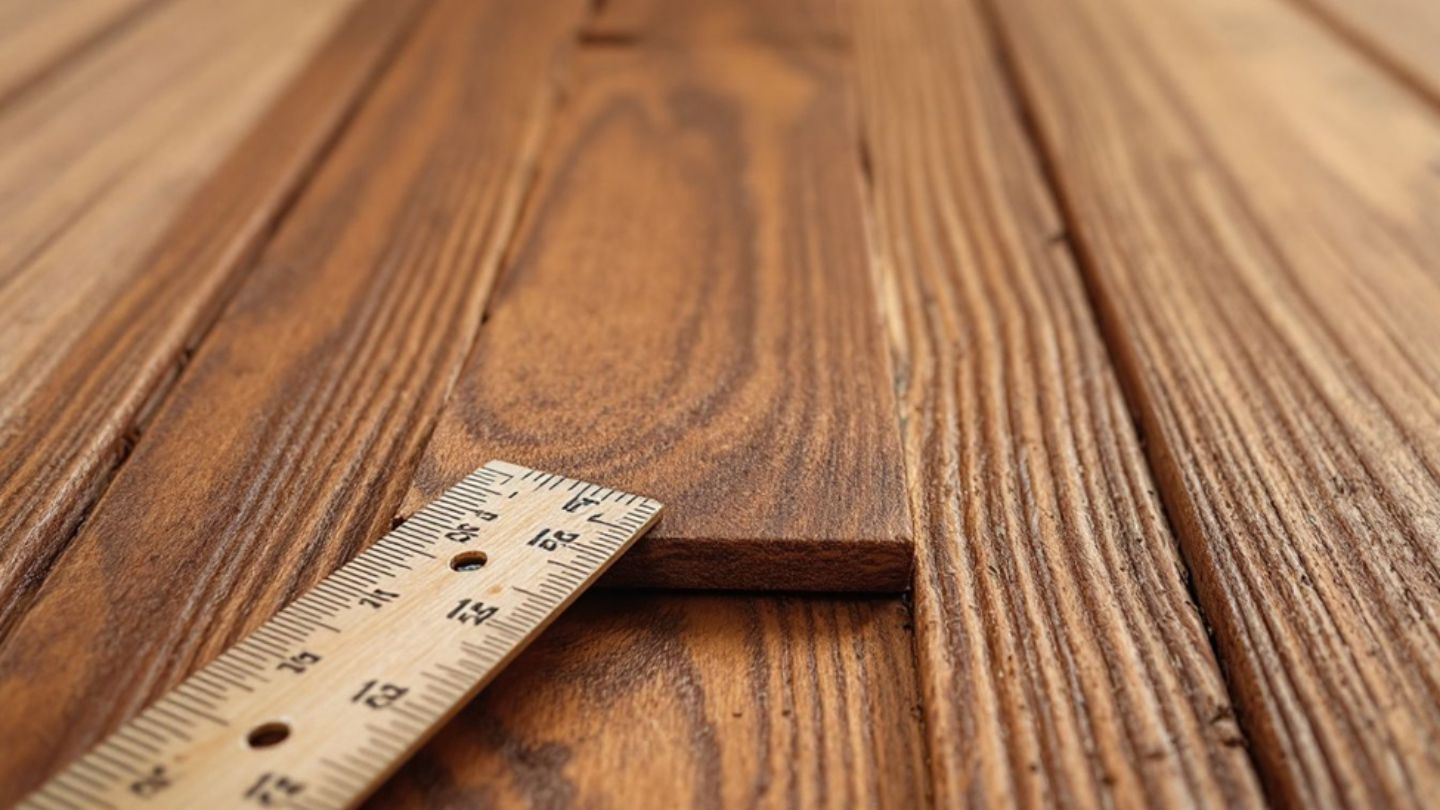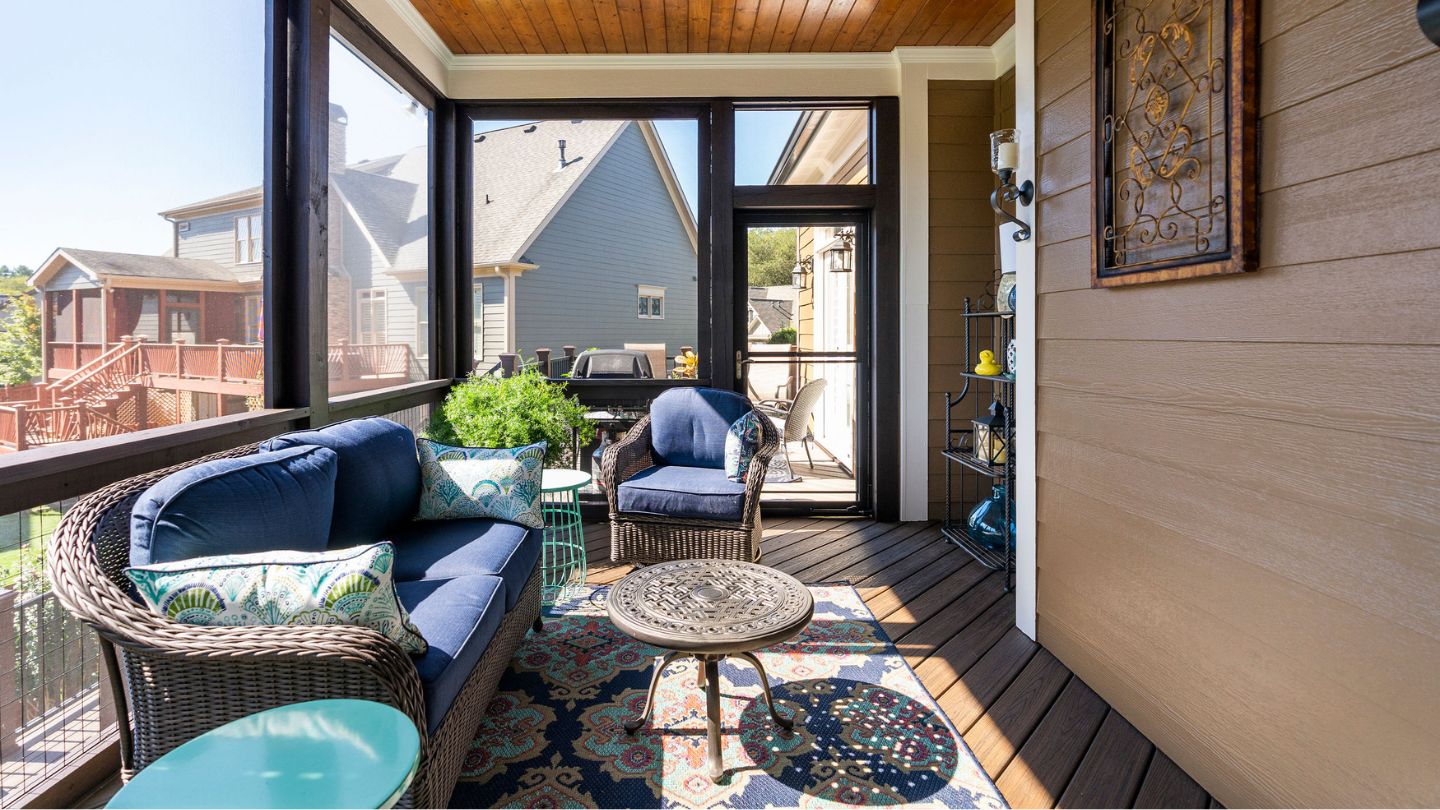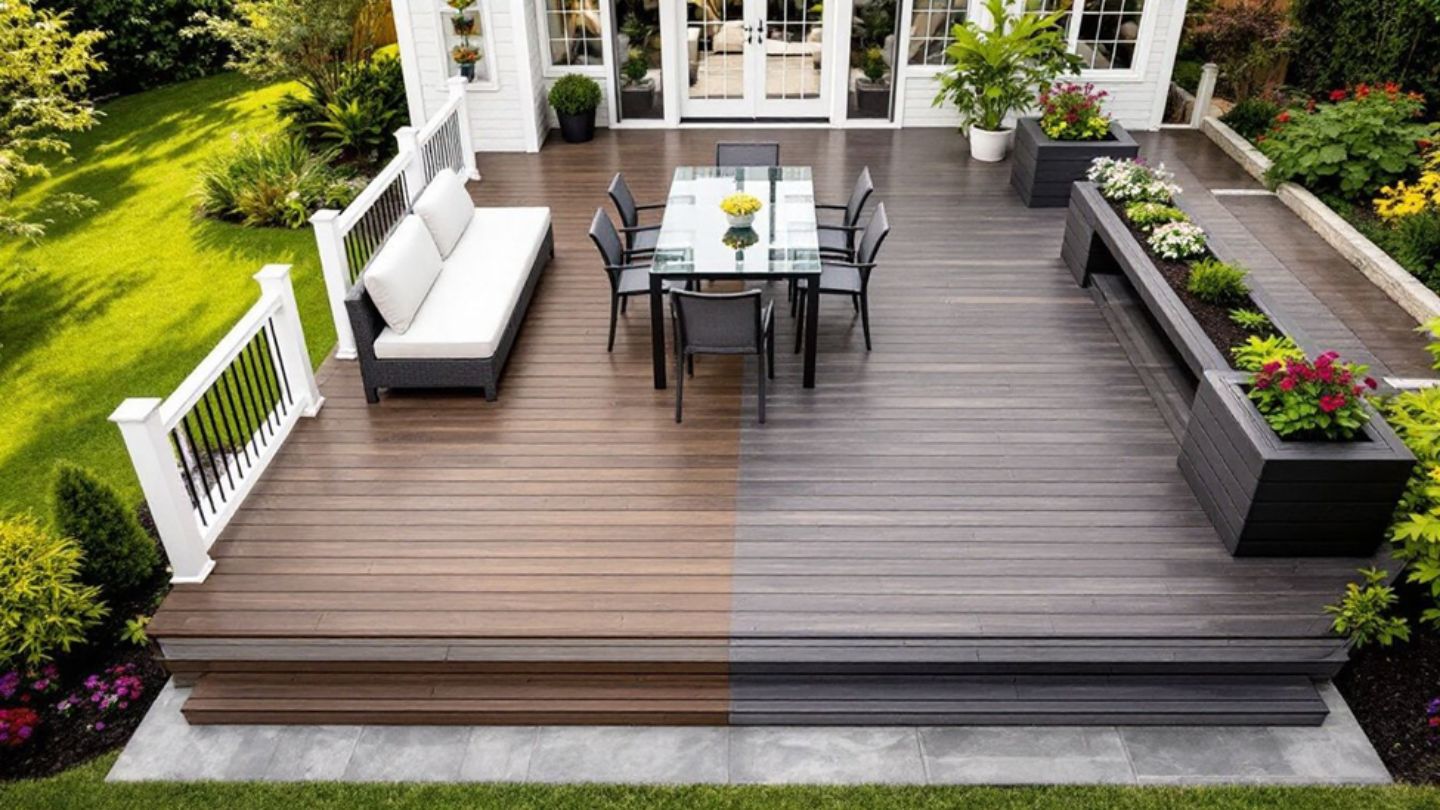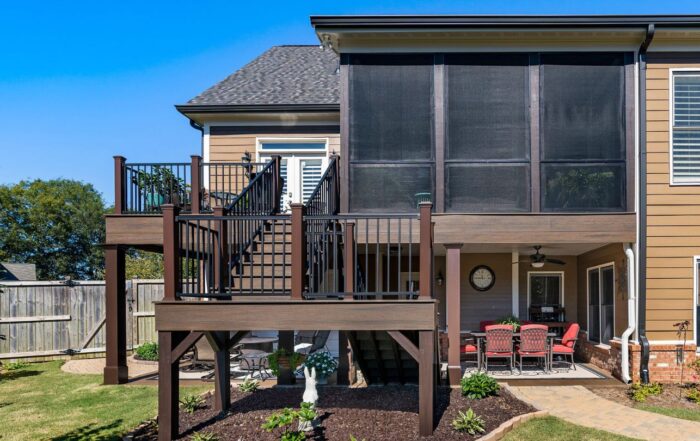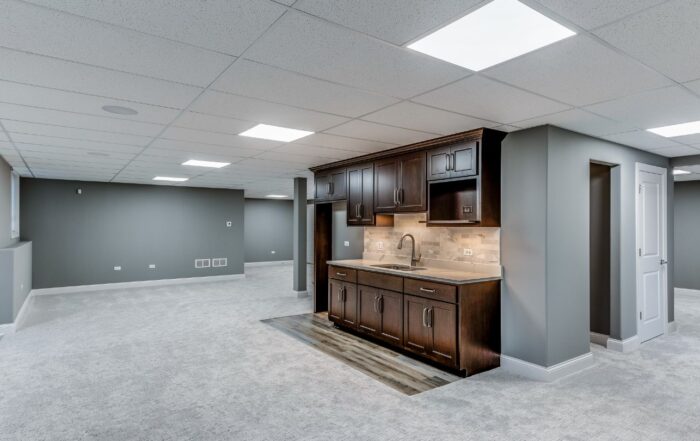PVC vs Composite Decking Material: Benefits and Differences Explained
Home
Blog
- PVC vs Composite Decking Material: Benefits and Differences Explained
When it comes to decking materials, PVC and composite are popular choices. But how do you decide which is better for you? This blog will explore the benefits and differences of PVC vs composite decking material benefits and differences, helping you make the best choice for your outdoor space.
Key Takeaways
- PVC decking is durable, moisture-resistant, and low-maintenance, but it has a higher initial cost, and its synthetic look may not appeal to everyone.
- Composite decking offers a natural wood appearance and is made from recycled materials, providing an eco-friendly option.
- When choosing between PVC and composite decking, consider factors such as aesthetic preferences, project requirements, and long-term value to determine the best fit for your needs.
Understanding PVC Decking
Decking materials crafted from polyvinyl chloride, or PVC, are synthetic and do not contain any wood fibers. This composition is notable for providing exceptional resistance to scratches, stains, and moisture, which makes it a perfect selection for outdoor elements such as trimmings and railings, along with creating an ideal PVC deck using PVC decking materials.
The array of colors and textures available in PVC decking varies greatly. Some options even mimic the look of natural wood grain. The diversity in appearance of these PVC deck boards enhances their adaptability for use on decks.
Key Benefits of PVC Decking
PVC decking is renowned for its impressive durability and low maintenance requirements. It resists common issues like mold and moisture damage, ensuring it retains its structural integrity and looks over time. PVC eliminates the need for regular maintenance tasks such as staining or sealing, offering homeowners both time and cost savings.
Technological advancements have further enhanced it for longer warranties and increased resilience, making PVC decking a solid long-term investment for those seeking a hassle-free outdoor space.
Drawbacks of PVC Decking
While PVC decking offers numerous benefits, it also has certain limitations. Typically costlier than composite materials, the price point of PVC can pose a challenge for homeowners who are mindful of their finances. If uncapped, PVC decks may be prone to staining and mold accumulation that could impact both their aesthetic appeal and durability.
Exploring Composite Decking
Introduced in the late 1980s, composite decking—a revolutionary blend of plastic, often high-density polyethylene, and wood fibers—has transformed the decking world. Composite decks are celebrated for their superior performance and aesthetic appeal, offering a divine combination of beauty and practicality.
Leading composite decking solutions are crafted to replicate the timeless elegance of natural wood while demanding minimal upkeep. This eliminates the need for labor-intensive tasks like painting or staining. Expert decking installers ensure a flawless finish, elevating any outdoor space to a sublime level of sophistication and functionality.
Advantages of Composite Decking
Composite decking offers the aesthetic appeal of natural wood, enriched by integrating wood pulp into its makeup, while also boasting a low-maintenance design that demands less care than traditional wood decks. This combination makes composite decking an appealing choice for individuals who prioritize both allure and practicality.
Environmentally speaking, composite decking is commendable as well. A significant number of these products incorporate recycled materials in their construction, which supports sustainability efforts. Such eco-conscious practices not only assist in minimizing waste but also present property owners with a more sustainable selection for enhancing their outdoor living areas.
Limitations of Composite Decking
While composite decking offers advantages, it is not without its drawbacks. The upfront expense exceeds that of traditional wood decking, posing a substantial economic factor for numerous individuals. However, its benefits often outweigh this initial cost concern for many homeowners.
The longevity of composite materials may be compromised if they are constructed from substandard recycled plastics and wood fibers. This can result in the necessity for occasional repairs or replacements as time progresses.
Cost Comparison: PVC vs Composite Decking
Regarding expenses, the upfront cost of PVC decking typically surpasses that of composite decking, with prices ranging from $10 to $15 per square foot for PVC and $4.50 to $13 per square foot for composite. Professional installers help homeowners plan budgets effectively, factoring in material quality, long-term value, and future maintenance to ensure the best investment for their outdoor space. When planning your decking project’s budget, it’s essential not only to account for the initial installation outlay but also future upkeep costs since they can greatly influence the total expenditure of your deck endeavor.
Long-Term Value
Both PVC and composite decking offer the advantage of requiring less maintenance, which translates into considerable savings in terms of time and money over an extended period. This reduced need for upkeep is a key factor that enhances their value when compared to traditional wood decking.
The durability aspect is vital since materials capable of enduring diverse environmental conditions are likely to last longer, thereby offering a superior return on investment.
Lifespan and Durability
Composite decking is designed to offer a perfect balance between durability and aesthetic appeal, typically lasting around 25-30 years. Its construction from high-quality recycled materials ensures both resilience and a reduced environmental footprint. While PVC decking might boast a longer lifespan, it often lacks the natural wood appearance that composite decks provide, which many homeowners prefer for their outdoor spaces.
Composite decks also offer a broader range of design options, allowing homeowners to achieve a more personalized look that complements their home’s aesthetic. Composite decking’s ability to combine beauty with practicality makes it a preferred choice for those seeking a harmonious blend of style and function in their outdoor living areas.
Therefore, selecting the right deck material for decking material is crucial for ensuring the longevity and low maintenance of your outdoor space.
Weather Resistance
Decking made from PVC is known for its resilience to decay and adverse weather effects, including resistance to ultraviolet rays and dampness, ensuring it remains durable over time. However, it often lacks the natural appeal many homeowners desire. Composite decking, on the other hand, stands out for its resistance to fading, stains, and mold growth, which bolsters its endurance in different climatic conditions while maintaining an authentic wood-like appearance.
When subjected to harsh weather situations, PVC decking sustains its stability without expanding or contracting, but it can feel less comfortable underfoot due to heat retention. In contrast, composite decking might exhibit some degree of distortion or warping, yet its superior design and material quality often compensate for this, providing a more comfortable surface and a visually pleasing finish.
Maintenance Requirements
While PVC decking requires minimal maintenance as it doesn’t necessitate staining or sealing, it often lacks the warmth and authenticity that composite decks provide. Composite decks, despite being labeled as low maintenance, do require regular cleaning to remove debris. However, this small effort is a worthy trade-off for the natural wood appearance and eco-friendly benefits that composite decking offers.
In summary, although PVC decking’s limited maintenance might seem attractive, the aesthetic appeal and environmental advantages of composite decking make it a more compelling choice for those who value beauty and sustainability in their outdoor spaces.
Environmental Impact
Today, many homeowners pay close attention to the environmental impact of their choices, particularly prioritizing sustainability and recyclability in the products they use. When it comes to decking materials, most composite decking is manufactured using recycled components, positioning composite as a greener choice over synthetic options due to its eco-conscious composition.
Sustainability of Composite Decking
Composite decking often gains recognition for its sustainability as it employs recycled elements such as discarded wood pieces and used plastics. The use of these reclaimed materials not only bolsters its environmental friendliness but also mitigates the emission of pollutants during its production process.
Crafted through a co-extrusion technique that applies heat and pressure, composite decking materials meld plastic with wood fibers to create a durable product. Opting for a composite deck can serve as an admirable substitute for conventional wooden options, presenting both eco-consciousness and longevity.
Eco-Friendliness of PVC Decking
Although PVC decking is fully recyclable, which contributes to its environmentally friendly appeal, it is often regarded as less eco-friendly due to the harmful chemicals that are a part of its makeup. Additionally, its synthetic nature may not resonate with homeowners who prefer a more natural look and feel in their outdoor spaces.
Installation Considerations
The installation of PVC and composite decking is best handled by skilled professionals who use specialized tools and techniques to ensure precision and durability. Composite decking often requires more attention to detail during installation, as its design allows for intricate patterns and custom shapes, enhancing the overall aesthetic appeal of the outdoor space. This meticulous approach ensures that composite decks not only meet but exceed expectations in terms of beauty and functionality.
Weight and Handling
Composite decking, although slightly heavier than PVC, offers a more robust and substantial feel, which contributes to its long-lasting durability. Professional decking teams are adept at managing the weight and placement of composite materials, ensuring a balanced and sturdy finished deck. The solid nature of composite decking materials provides a sense of permanence and quality that lighter alternatives may lack.
Fastening Systems
The installation of composite decking, while requiring a bit more expertise, results in a superior and seamless finish. The use of hidden fasteners with composite decks not only enhances their visual appeal but also contributes to their structural integrity. This attention to detail in the fastening process ensures that composite decks maintain their elegance and durability over time, offering a refined appearance that elevates any outdoor area.
Aesthetic Appeal
The material selection for your deck is greatly influenced by its visual attractiveness. Composite decking is celebrated for its ability to seamlessly blend with natural surroundings, offering a warm and inviting look that enhances the aesthetic appeal of any outdoor space. Its realistic wood grain patterns and variety of colors make it a superior choice for those who value an authentic appearance.
Design Versatility
Composite decking offers a multitude of design possibilities, enabling the improvement of outdoor areas. These composite materials come in an array of colors and eliminate the need for painting or staining, offering adaptability to complement different outdoor designs. The use of hidden fasteners with composite decks adds to their visual appeal by creating a clean finish. Selecting composite decking can significantly enhance the appearance of your exterior space, highlighting the advantages associated with using these materials.
When deciding on which decking material is most suitable for achieving your desired outdoor ambiance, it’s important to consider personal taste in aesthetics as well as how much maintenance you are willing to undertake.
Real Wood Appearance
Composite decking is carefully crafted to emulate the natural beauty of wood, with detailed grain patterns that add character and warmth to outdoor spaces. Professional decking services ensure that these materials are expertly installed, highlighting their realistic wood-like texture and complementing the overall design of your property. In contrast, the texture of PVC decking often appears distinctly plastic-like, which may make it less attractive than its composite counterpart when striving for a natural wood appearance.
In deciding between PVC and composite options for decking, homeowners should weigh up how well each choice emulates natural wood’s look to satisfy their personal taste in aesthetics.
Safety Features
Composite decking enhances the safety of outdoor spaces by providing non-toxic surfaces that are safe for families with children. Its superior slip-resistant qualities make composite decking a safer choice for maintaining safety in wet environments, ensuring well-being in your external areas.
Slip Resistance
Composite decking products are often treated to improve grip in wet conditions, enhancing slip resistance. The textured surface of these boards provides safety within outdoor spaces during humid or rainy weather, making them an ideal choice for families.
Heat Retention
When selecting decking materials, their ability to retain heat is crucial, as it affects comfort during warm sunny days. PVC decking tends to absorb more heat, leading to a hotter surface underfoot compared to composite decking. On sweltering days, composite decking offers a cooler walking surface, providing greater comfort. When weighing options between PVC and composite for your deck, consider how each material’s heat retention will impact the usability of your outdoor space.
Choosing the Right Material for Your Deck
Selecting the right decking material involves considering durability, maintenance, and overall aesthetics, with both composite and PVC offering unique advantages. However, composite decking truly excels by combining the beauty of natural wood with eco-friendly benefits, making it a preferred choice for those who value sustainability and style. Professional decking specialists assess project specifications, recommend the ideal material, and ensure that the final design aligns perfectly with your needs and vision.
Recognizing these variances is key in making sure that your choice of either composite or PVC deck materials aligns with your personal living standards as well as your financial plan.
Project Requirements
When evaluating the expenses of PVC compared to composite decking, it’s apparent that although PVC usually incurs a greater upfront cost, its enduring quality and reduced maintenance needs provide superior long-term benefits. However, composite decking stands out for its ability to replicate the warmth and charm of natural wood, offering a more inviting outdoor space. The installation process for PVC decking can be more straightforward than that for composite materials, which might necessitate particular tools and methods to ensure proper installation.
In terms of resilience and longevity, PVC decking typically withstands moisture and environmental factors better than composite decking does. However, composite decking is engineered to resist fading and maintain its vibrant appearance over time, offering a lasting appeal. The distinct makeup of each material affects their respective environmental footprints and potential for recycling, with composite decking often leading the way in sustainable practices.
Personal Preferences
The selection of decking materials is significantly influenced by individual aesthetic tastes. Those with a penchant for modern design might find the clean, chic look of PVC decking particularly appealing. However, composite decking provides an appearance that closely resembles natural wood, creating a cozy and traditional vibe suitable for homes with classic designs.
Homeowners have the flexibility to pick from a diverse palette of colors and textures when it comes to both PVC and composite decking options, ensuring they can match their unique style preferences. Ultimately, composite decking offers a more versatile and eco-conscious choice for enhancing any outdoor space.
Summary
In conclusion, while PVC decking offers durability, it often lacks the natural charm many desire. Composite decking stands out with its wood-like appearance and eco-friendly features, offering versatile design options. Despite needing slightly more upkeep, its blend of style and sustainability makes it the preferred choice for homeowners prioritizing aesthetics and environmental responsibility.
At Bradford Crafted, we specialize in crafting expertly designed and professionally installed decks that align with your vision and elevate your outdoor living experience. For those in Alpharetta, explore our composite decks to discover the perfect blend of style and sustainability. Contact us today to explore the best decking solutions for your home and bring your dream deck to life. Let’s transform your outdoor space into a stunning retreat!
Frequently Asked Questions
1. How does composite decking handle extreme weather conditions?
Composite decking is designed to resist fading, warping, and mold growth, making it durable in both hot and humid climates as well as colder environments.
2. Can composite decking be customized for specific designs or shapes?
Yes, composite decking is versatile and can be cut, shaped, and installed to suit unique designs, including curved edges and intricate patterns.
3. Is composite decking safe for pets and children?
Composite decking is slip-resistant and free of splinters, making it a safer option for pets and children to enjoy outdoor spaces.
Table of Contents
Recent Blogs
Top Qualities to Look For in A Composite Deck Contractor
Searching for a composite deck contractor? Knowing the essential qualities to prioritize when selecting a company is crucial to ensure [...]
4 Great Reasons You Should Renovate Your Basement Today
Thinking about renovating your basement? Here are four great reasons you should renovate your basement now. Turning an underutilized space [...]
Top Things to Consider When Building a Porch in Milton
Planning to build a porch in Milton? There are several important things to consider when building a porch in Milton, [...]

